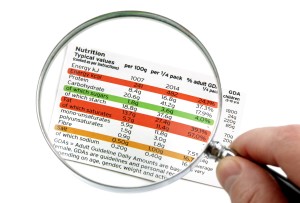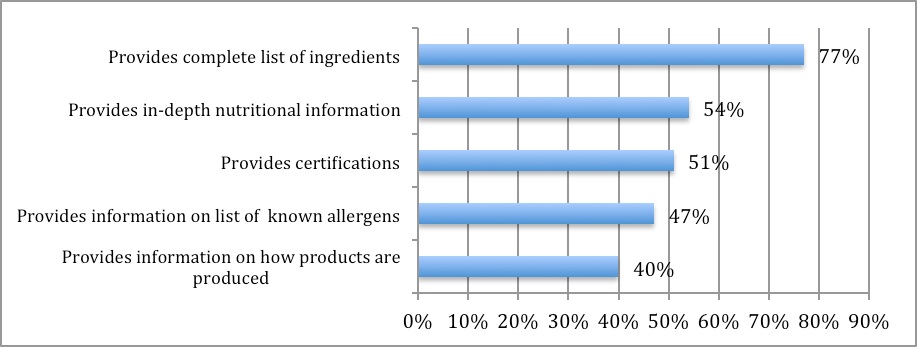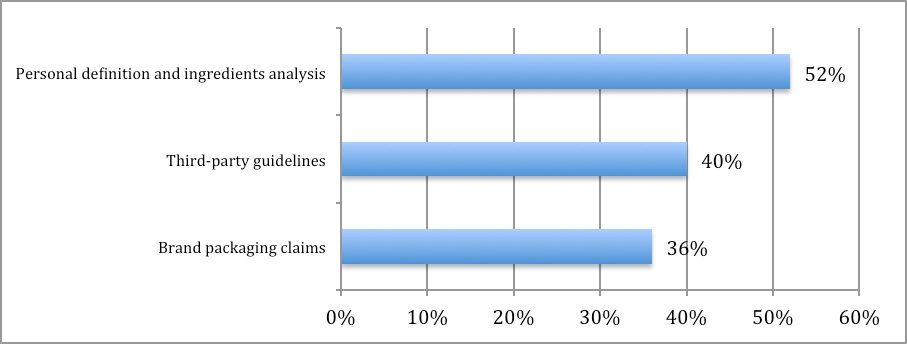GROCERY WARS – “WINNING CUSTOMER LOYALTY IN THE AGE OF PRODUCT TRANSPARENCY”!
Higher product transparency is increasingly becoming a global business requirement for companies across multiple markets and industries. So what is the definition of product transparency with respect to the food sector, which consumer segment is driving this initiative and what does it mean for the brand?
What is Product Transparency?
Consumers are demanding value transparency when it comes to the packaged goods sector. Though the definition of
transparency has not been widely understood, a consumer survey defines a transparent brand as “One that provides all information about a food or personal care product to allow shoppers to determine for themselves if the product is a fit”. Chart 1 outlines the Top 5 factors that consumers use to determine whether a food manufacturer is being transparent.
Chart 1
Factors That Determine if Food Manufacturer is Being Transparent
What Consumer Segment is Driving Product Transparency?
Though most consumers today seek full product transparency, in particular it is the Millennial Mom who is leading this charge. Specifically, when it comes to food products, they want access to detailed product information in order to determine for themselves what food is healthy for them. In a recent study, Millennials Moms revealed it is 4x more important they understand the product ingredients of the product they wish to purchase than the brand they have chosen. Food safety, nutritional information and environmental impact are their greatest concerns. Chart 2 outlines the Top 3 ways consumers determine if a product is healthy.
Chart 2
How Consumers Determine if Product Is Healthy
The Demand for Product Transparency!
The demand for product transparency evolves around:
1. Consumers trust in brands and
2. Consumers’ dietary needs.
A recent study revealed 35% say they are sometimes confused by what the labels on the food are actually saying and in the process is losing faith in brands. In the same study, the majority of consumers (81%) revealed they had consumed a packaged product with an ingredient they did not recognize in the past month. In addition, 53% of the respondents revealed they shop according to a specific diet.
Evolution in the United States!
In the United States DigiMarc has created a technology driven mobile engagement barcode for food manufacturers. By scanning this code, consumer can access all relevant information with respect to a products ingredient. For example, Unilever, a strong supporter of this new technology now allows consumers who purchase Hellman’s mayonnaise to learn what US state provides the soybean for this product.
Product Transparency, The Opportunity For Food Brands!
Brands that understand these evolving behaviours and successfully address the need for greater product transparency and increased consumer access to information will be poised to increase their market share. According to acomprehensive new survey from Label Insight, they revealed,
- 94% of shoppers will be loyal to a brand that offers complete transparency.
- 73% would be willing to pay more for a product that offers complete transparency.
- 39% more likely to switch to a brand if it offered full product transparency.
Brands that embrace this initiative will reap the rewards. Those who don’t will continue to look from the outside in – trying to get listed in the grocery sector.
For more help Getting and Staying Listed in Canada’s Grocery Sector, connect with us through our website: www.fooddistributionguy.com or give us a call toll-free: 1-844-206-FOOD (3662).








